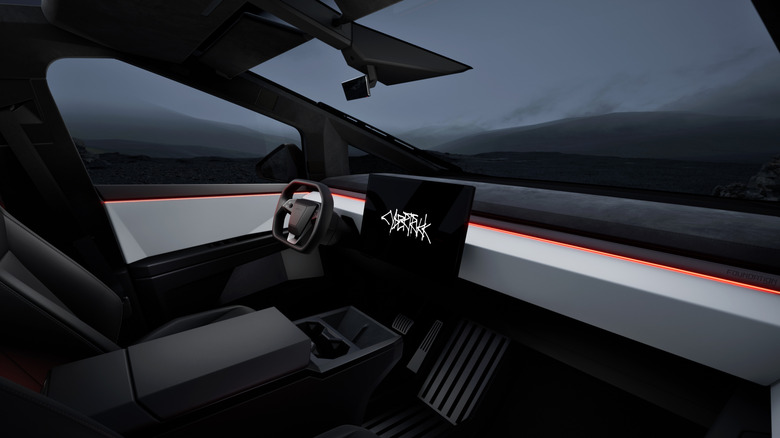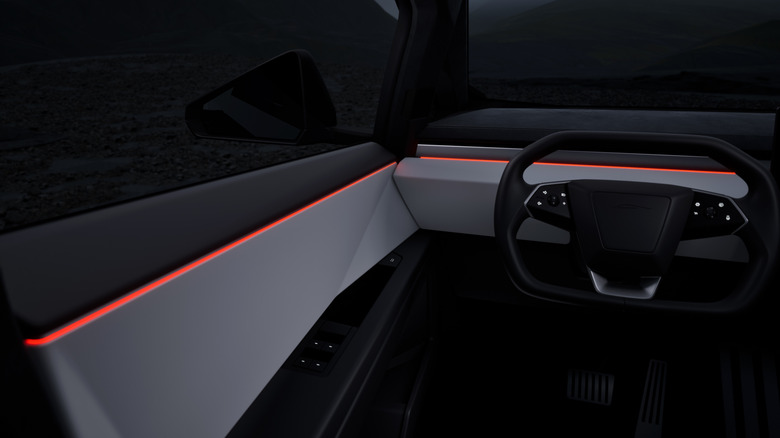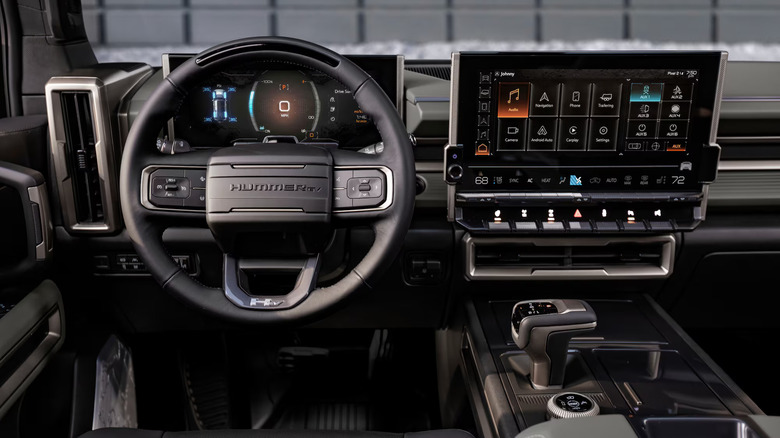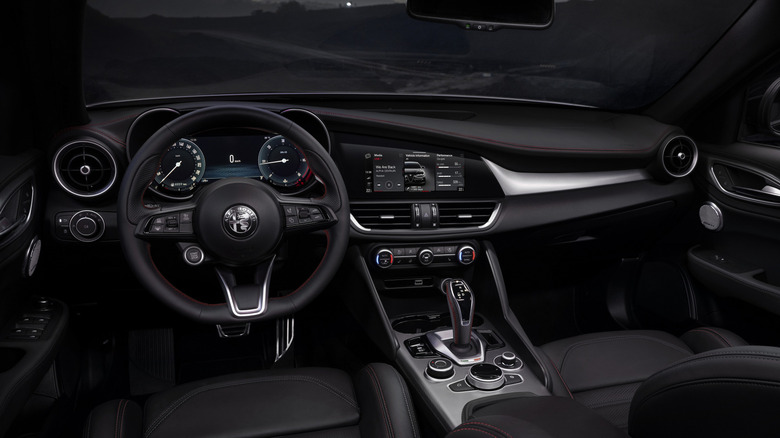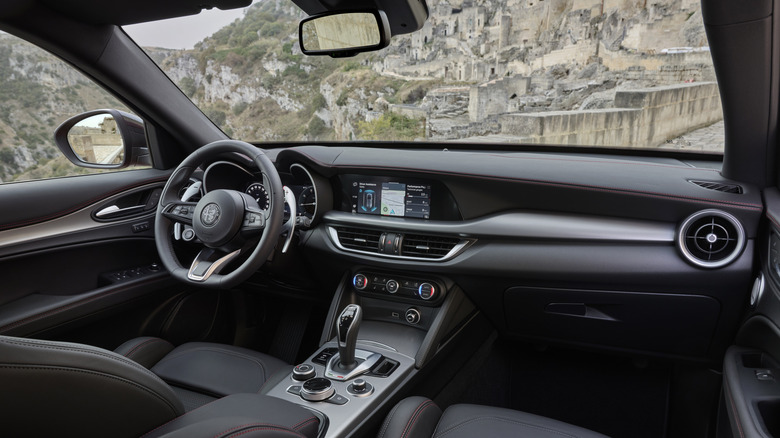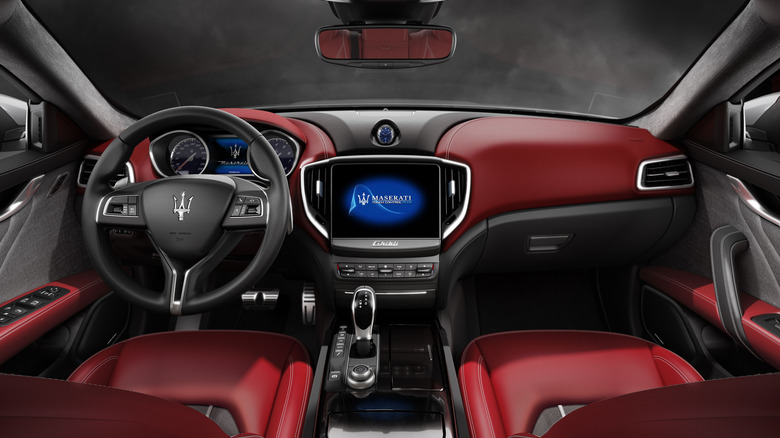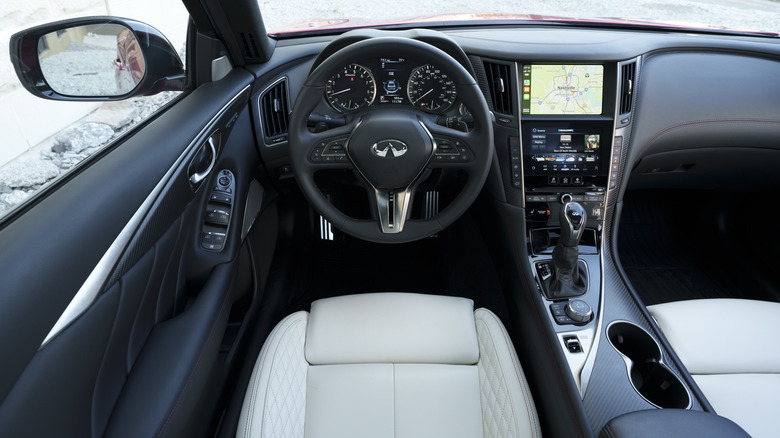6 Expensive Cars With Cheap-Looking Interiors
Buyers everywhere are ready to spend more money to get a more luxurious experience, and that is nowhere more apparent than in the car industry. Brands like BMW and Mercedes-Benz sell millions of cars each year, meaning there is a huge market for premium vehicles. But what do buyers actually want from a luxury car?
Of course, they expect a more refined driving experience, with better sound insulation and comfort. The availability of more powerful powertrains also plays its role, and there is something to be said about the car's overall look. But perhaps the biggest difference between regular and luxury cars is interior quality — people spending big bucks expect car brands offering the nicest interiors possible. Materials like leather and metal, rather than just plastic. A better fit and finish are, too. Most premium vehicles will also have larger, better screens to add to the ambiance.
Unfortunately, some automakers missed that memo, offering expensive vehicles with cheap-looking interiors. In some, you are maybe paying more for performance or other aspects, but that doesn't change the fact that you'll be spending your time in a sea of cheap plastic — perhaps even in a vehicle that costs six figures! Here are some of the worst offenders.
Tesla Cybertruck (2023 to present)
Remember in 2019 when Elon Musk promised that Tesla's cyberpunk electric truck would start at $39,900? Well, today it starts at $72,235 (before tax credit), with the top-end model costing north of $100k. Hop inside, and it still looks like a $40,000 vehicle, though. The minimalist Ikea aesthetics are pleasing to the eye, and the humongous 18.5-inch touchscreen adds a dash of futurism, but screens are cheap these days.
Keep your eyes on one area — any area — for longer, and the Cybertruck interior begins to reveal its true face. Cheap-looking plastic is almost everywhere. Upper dashboard, lower dashboard, you name it. Not only that, but owners are reporting squeaks and rattles. Also, where is the stitching? The leather? Heck, we would've been satisfied with faux leather! Instead, the Cybertruck interior looks like it belongs to an economy car.
Even a lowly Corolla looks nicer, with stitching, soft-touch plastics, and different textures. A more apt comparison, the 2025 GMC Sierra 1500 starts below $40,000, and yet its interior looks miles ahead the Cybertruck in terms of perceived quality. In fact, most other pickup truck brands offer nicer interiors.
Sure, battery technology is expensive, and the Cybertruck is impressive in other areas, but at its price, it should have a nicer cabin. Maybe some metal accents to make it appear plusher? Or a screen in front of the driver, because it would also boost safety? Instead, basically all you get is nicely integrated ambient lighting.
GMC Hummer EV Pickup Truck & SUV (2021 to Present)
We mentioned GMC's Sierra 1500 earlier, but GMC doesn't always nail it either. The Hummer EV looks nicer inside than the Cybertruck, but its not nearly as luxurious as a six-figure vehicle should be.
In our 2025 GMC Hummer EV SUV review, colleague Alex Hevesy found the interior lackluster, at best. No leather seats or inserts. No fancy stitching. Oh, and the cabin feels cramped, almost like you're sitting in a coffin. In a 216.8-inch vehicle, that's frankly unacceptable. Yes, the tough dashboard design has some merit, but overall, it looks rather cheap.
Hey, at least GMC incorporated a 12.3-inch screen in front of the driver, alongside the relatively large 13.4-inch center unit. The software graphics that run on those screens are also neat, which isn't at all surprising, because they were developed by Epic Games. Still, the software can be laggy at times — again, not something you'd want on a six-figure vehicle.
Still, the GMC Hummer EV pickup truck is all about compromises. It has a 212-kWh battery — the biggest of any EV to date, yet it delivers only 329 miles of range. Not bad, but the Cybertruck has a 122.4-kWh battery and 325 miles of range. With lithium-ion battery manufacturing being CO2 intense and bad for the environment in numerous other ways, we should be looking into making more efficient EVs. Instead of slapping the biggest possible battery, maybe GMC should make the Hummer EV more efficient and nicer inside?
Alfa Romeo Giulia (2016 to Present)
When I first drove the latest Giulia at a press event in 2016, I was immediately impressed by its super responsive, playful chassis. Alfa Romeo's stunning RWD sedan felt like a sports car, even next to the BMW 3-Series. Subsequent test drives really made the Giulia feel like the Lotus of sedans, but also showed that its interior had no place in a premium vehicle.
Alfa Romeo's designers did their job; the dashboard looks driver-focused, just the way it should in a sports sedan, with the turbine-like circular vents connecting the dots almost perfectly. However, the overall feel inside the cabin is gloomy. The material quality, even in the latest refreshed model, is nowhere near that of the Germans. Yes, Alfa Romeo used soft-touch plastics, but all textures feel the same, and there is no stitching on the dashboard. Compare it to the latest 3 Series or C-Class, and the Giulia looks downright cheap.
That's before we even start talking about the screens. In front of the driver, Alfa Romeo has started implementing a large 12.3-inch fully digital instrument cluster, which looks quite nice, but the same was true for the pre-facelift analog dials. However, the infotainment screen measures only 8.8 inches diagonally, which is small by 2025 standards. It's also nestled inside big bezels, which give off a cheap vibe. Hey, at least it's better than the initial entry-level Giulia, which had a tiny 6.5-inch display with comically large bezels.
Alfa Romeo Stelvio (2016 to Present)
The Stelvio shares the platform with the Giulia sedan, so it should be no surprise that they have similar interiors. The one's dashboard is a bit more traditional — the screen isn't nestled in a weird shape with irregular angles — and as a result, it looks a bit more harmonious. This means the infotainment screen has smaller bezels, but it also loses some of the Italian flair of the Giulia.
The pre-facelift Alfa Romeo Stelvio we tested in 2017 had an unusually wide screen, and it looked almost like a letterbox. That was rectified in 2021, when Alfa Romeo changed the dashboard design to incorporate a unit with a more normal aspect ratio. The current screen still looks dated, though, especially next to the BMW X3's stunning, high-definition displays. At 8.8 inches, it's on the small side, too.
However, the biggest letdown is the perceived quality. While Alfa Romeo has improved on that aspect throughout the years, with soft-touch plastics, leather-like surfaces, and stitching giving a more luxurious vibe, for its price, the Stelvio looks cheaper than it should. Any of its competitors feel better on the inside, including the significantly cheaper Lexus NX. Heck, the Genesis GV70 looks like a Rolls-Royce in comparison.
It's a shame, because the Stelvio is easily the most engaging SUV I have ever driven, with the Giulia's sharp driving dynamics jammed in an equally stylish body. Let's hope that Alfa Romeo improves the interior quality for the next-gen 2027 Stelvio, without making it duller to drive.
Maserati Ghibli (2013 to 2025)
The Ghibli wasn't updated for the 2025 model year, as Maserati will be killing its performance sedan soon. It's a shame, because it is quite the unique vehicle, with Italian flair and Ferrari-sourced engines. According to most publications, it's nice to drive, with balanced and agile handling. The 3.8-liter twin-turbo V8 version is potent, too, producing 572 hp, and more importantly, a satisfying sound.
Hop inside, and the Ghibli welcomes you with a stylized dashboard that has some unique touches, like a nicely integrated analog clock. And if you choose the interior with red or brown accents, it looks quite exotic, too. So, what's the problem then? Well, the quality is sub-par. The 2024 Ghibli started at $110,000, yet the interior materials didn't live up to the eye-watering price. The Ghibli borrows most of the switchgear from other Stellantis products, which look out of place inside a luxurious performance sedan.
Moreover, the design, while certainly unique, looks a bit dated. Put it next to the latest BMW 5 Series and Mercedes-Benz E-Class, and it looks at least two decades older. That's hardly surprising, as it was launched way back in 2013. So, instead of forward-looking, high-definition screens, you are getting a 10.1-inch unit in the middle. There is also a small screen in front of the driver, nestled between two analog dials, which looks even more dated. At least the latest Ghibli refresh ran the modern Android Automotive operating system.
Infiniti Q50 (2013 to 2024)
The Q50 was discontinued last year, turning Infiniti into an SUV-only brand. It was a long time coming, as, just like the Maserati Ghibli, the Japanese sports sedan was introduced in 2013. Naturally, the Infiniti Q50 was aging out near the end of its lifespan. This could be felt through the driving experience, with the steering and suspension lacking feel and confidence. That's quite unfortunate, because the 3.0-liter twin-turbo V6 was quite lively, particularly in the 400-hp tune.
It was the same story inside. In true Infiniti fashion, the material quality inside the Q50 is top notch, with matte wood and leather providing nice ambiance. Unfortunately, the cabin didn't look expensive. The dashboard layout was simply too dated, with a 2000s era design. All Q50's competitors already looked more elegant and plusher inside.
Still, the biggest issue was the dated infotainment system. Interestingly, the Q50 has two center screens stacked one atop another. The upper screen is for the navigation, while the lower one is for multimedia. But there are also many buttons around, making the center console look very convoluted.
Start the Q50, and the Windows 7 era graphics make things even worse. In latter models, you can have a more modern Android Auto/Apple CarPlay interface on the upper screen, but the lower screen will still display Infiniti's appalling software. It looks so jarring and out of place in a premium sedan. Even the fun-to-drive Lexus IS 500, with its interior design harking back to 2016, looks way more coherent and expensive inside.
